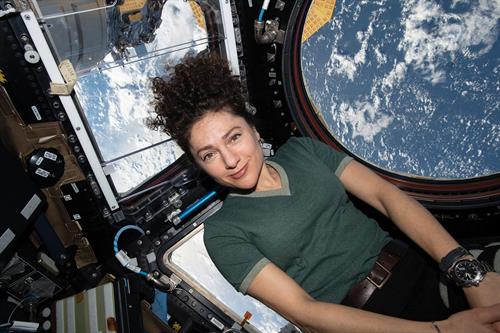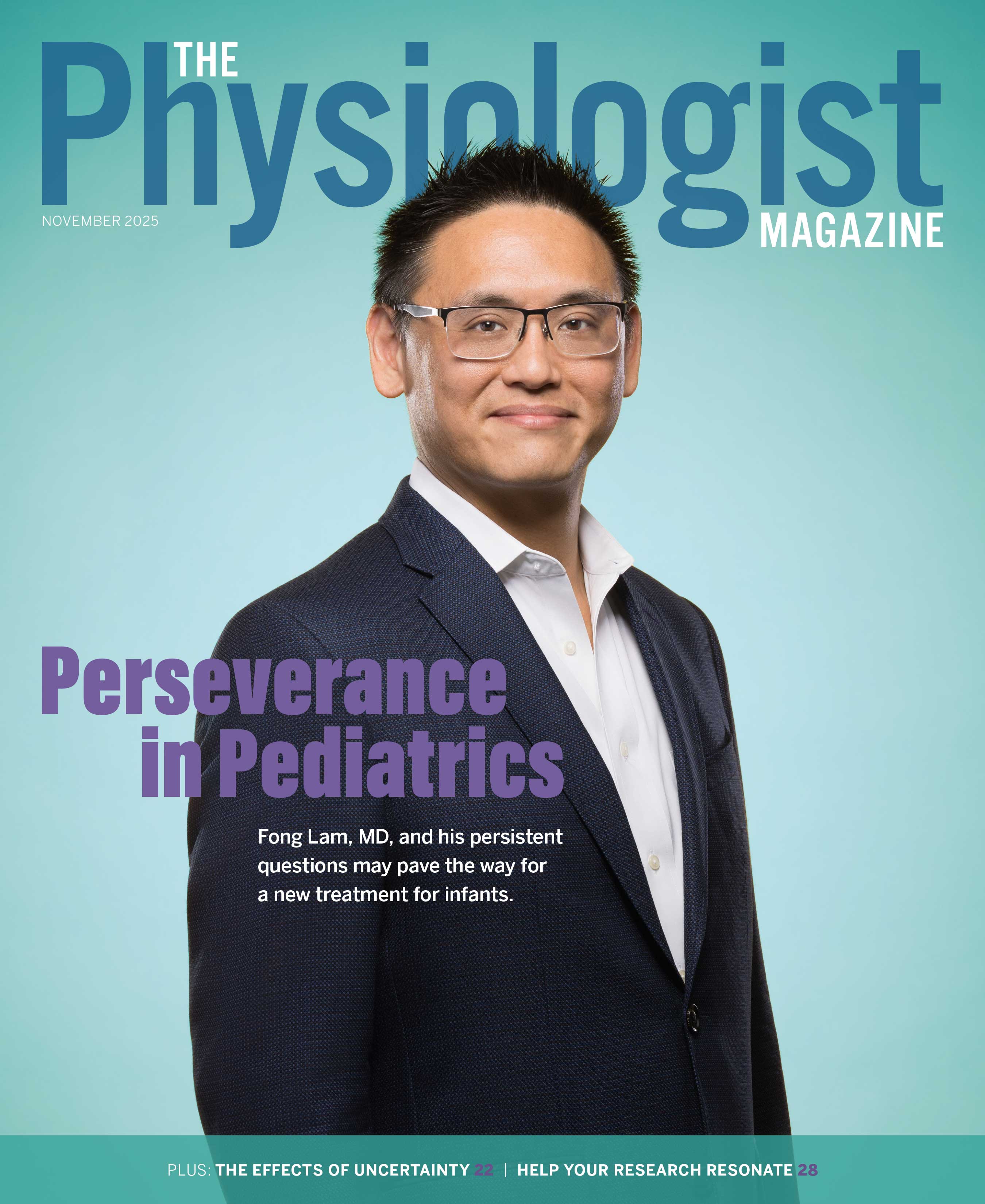The Physiologist Magazine
Read the Latest Issue
Don’t miss out on the latest topics in science and research.
Contact Us
For questions, comments or to share your story ideas, email us or call 301.634.7314.
The World in Her Sights
What's it like to live and work on the International Space Station? Astronaut and comparative physiologist Jessica Meir talks about her adventure off the planet.
By Stacy Brooks and Dennis Brown, PhD

Jessica Meir, PhD, is a member of a very exclusive club. She is one of only 242 people in the world who have ever visited the International Space Station (ISS)—the large orbiting spacecraft that hosts an international mix of crewmembers, equipment and experiments, helping all of us on Earth learn and understand more about living and working in space.
In March, The Physiologist Magazine had the opportunity to interview Meir from the ISS as she was finishing up her almost seven-month stint. During her Skype video conversation with APS Chief Science Officer Dennis Brown, PhD, Meir shared the vital role that physiological research is playing as NASA sets goals of sending astronauts back to the moon and eventually to Mars.
Physiology in Space
Physiology is one of the most important disciplines when discussing human space exploration, Meir says. "We need to understand the effects that the space flight environment and microgravity have on the human body. We've definitely made impressive progress over the now decades of research of human spaceflight, but there still are some pretty big unanswered questions, particularly those dealing with radiation."
Meir and the other astronauts on the ISS spend a lot of time in pursuit of these and other answers as they conduct multiple experiments sent to space by researchers from around the world. But that's far from all they do, and on the ISS today, research isn't left up to only the scientists.
"One of the nice things about our roles on the Space Station now is that all astronauts and cosmonauts are really created equal," Meir says. "It's different than things were back in the shuttle program, where the commander and the pilot really focused on being able to land the space shuttle, while others were more focused on science or spacewalks. But now, since we have these long-duration missions—typically about six months—we all have to be able to do everything."
The Making of an Astronaut
Meir attended Brown University in Providence, Rhode Island, as an undergraduate before receiving a master's degree in space studies from International Space University in Strasbourg, France. She earned a PhD in marine biology from Scripps Institution of Oceanography at the University of California, San Diego, where she studied diving physiology of marine mammals and birds. Her postdoctoral work was conducted at the University of British Columbia in Vancouver, Canada.
Before her selection to the 21st NASA astronaut class in 2013, Meir accepted an assistant professor position at Harvard Medical School/Massachusetts General Hospital, working as a marine biologist and physiologist. Her research involved studying "charismatic megafauna"—large animals such as emperor penguins, elephant seals and bar-headed geese. She participated in Smithsonian Institution diving expeditions to Antarctica and Belize. She also found time to become a pilot and learn conversational Swedish. Later, as an astronaut, she learned Russian.
Meir continued to add to her previous accomplishments aboard the ISS, racking up an impressive list of accolades. After her 205-day mission, she ranks sixth on NASA's list of single space flight record holders. She was one of two women, along with crewmate Christina Koch, MS, to conduct the first three all-female spacewalks, logging 21 hours and 44 minutes in spacewalking time. And during her mission, Meir completed 3,280 orbits of the Earth and traveled a total distance of 86.9 million miles.
She says her diverse scientific training prepared her well for the rigors of being an astronaut. The research process, however, "is a lot different from being in academia, where we have a lot of freedom and a lot of flexibility in our schedules, our roles and in what we do.
"On the research front, it's just the same. NASA sends out a call for proposals, just like you would have through NIH or NSF, and the science that's selected for that mission is what we end up carrying out. We as individual astronauts onboard don 't really have any say in that."
Though she may not have been involved with the selection of the research experiments on the expeditions, the enthusiasm Meir holds for the work being done is clear. She described several of the experiments she and her crewmates were running, including some in which the astronauts themselves were the test subjects.
For example, the Cardiac and Vessel Structure and Function with Long-duration Space Flight and Recovery (Vascular Echo) study examines changes in blood vessels and the heart while in space and following return to Earth. "It's an interesting study building on other data sets of experiments they 've already done, and they've actually seen some pretty impressive effects, " Meir says. "They 've shown that even in a six-month mission, if you look at the carotid artery, for example, the walls of the artery are actually getting thicker and stiffer during space flight, similar to the aging process but in a very much accelerated fashion.
"Some of these changes are equivalent to about 20 to 30 years of aging, which is of course very significant," she explains. "The question of the mechanism behind that and whether or not it persists when we return to Earth is also something we need to know more about."
In the few days leading up to The Physiologist Magazine interview, Meir conducted that experiment, getting ultrasounds and echocardiograms to image various blood vessels. "Today, I'm taking my blood pressure every hour, and there are some blood samples associated with that in order to try to look at that problem from many different sides. "
She explained another study in which her crewmate Andrew Morgan, MD, was the subject for a "fluid shifts " experiment, which aims to understand more about the upward shift of body fluids experienced in microgravity. "Some astronauts experience vision deficits and some morphological changes to the eye and even to the retinal layer itself during and after spaceflight, " Meir explains. "Some crewmembers develop folds in the choroid layer and edema of the optic disk. Luckily, so far, none of those changes have led to any long-term significant problems or pathology post-flight. But, we really need to understand the mechanism behind that to make sure that we can maintain the long-term health of astronauts. "
That particular experiment, Meir says, was especially packed with cool physiological research. "We were using ultrasound. We were using a lower-body negative pressure machine in the Russian segment so that we could actually return blood flow temporarily to take measurements. We were doing tonometry to measure pressure in the eye as well and OCT to image the eye. So it was a really multi-faceted approach to examine aspects of these fluid shifts. "
With so much of Meir's recent work focused on how humans might fare on extended missions to space, we had to end our interview with a fun hypothetical question: Which of the diving and flying animals that she previously studied would do the best in the harsh environment of space?
"The animals that I studied were real extremophiles—the most elite divers in their classes—and high-altitude animals—animals that are exceptional in their capability, even in the animal world. Of course, though, space is the ultimate of extreme environments. Neither humans nor any of those animals would be able to survive freely in the vacuum of space since we 've all evolved on planet Earth.
"But, I guess in a fun way I'd have to pick the emperor penguin. You can see how agile they are when they 're diving beneath the surface, and I think that they would be able to adapt to moving around in micro-gravity quite well," Meir says.
Want to see more of our conversation with Jessica Meir? Watch the full interview at https://bit.ly/APSInterviewWithJessicaMeir.


